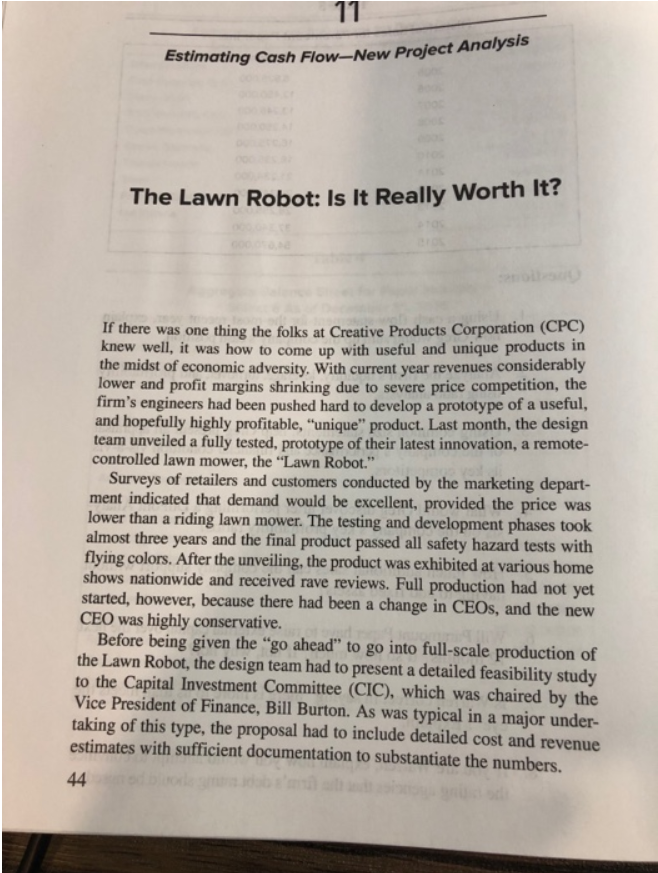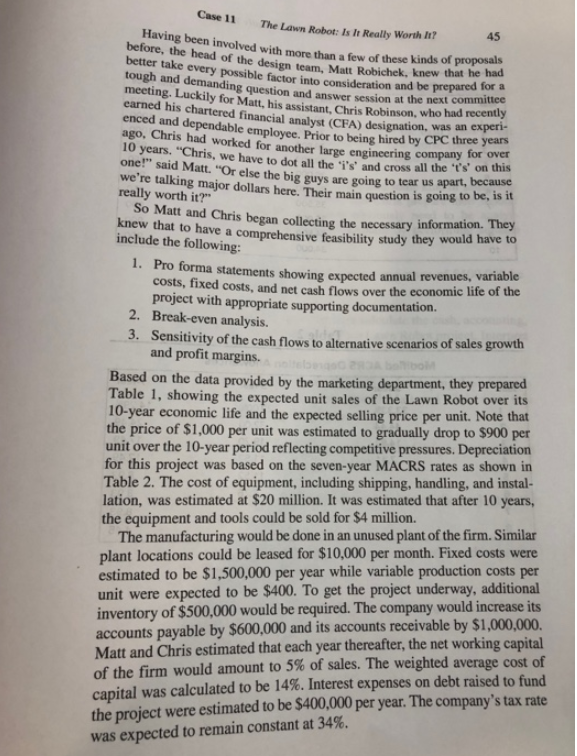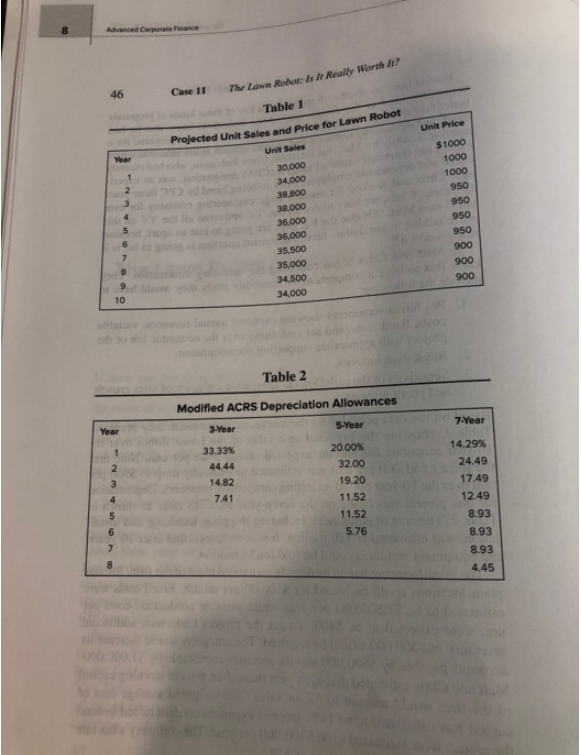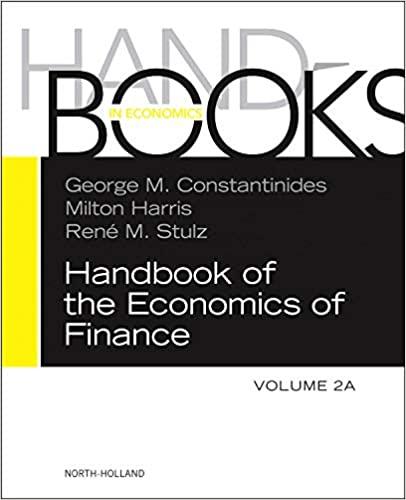Question
Please answer Question 1 through 3 Estimating Cash Flow-New Project Analysis 11 The Lawn Robot: Is It Really Worth It? If there was one thing



Please answer Question 1 through 3

Estimating Cash Flow-New Project Analysis 11 The Lawn Robot: Is It Really Worth It? If there was one thing the folks at Creative Products Corporation (CPC) knew well, it was how to come up with useful and unique products in the midst of economic adversity. With current year revenues considerably lower and profit margins shrinking due to severe price competition, the firm's engineers had been pushed hard to develop a prototype of a useful, and hopefully highly profitable, "unique" product. Last month, the design team unveiled a fully tested, prototype of their latest innovation, a remote- controlled lawn mower, the "Lawn Robot." Surveys of retailers and customers conducted by the marketing depart- ment indicated that demand would be excellent, provided the price was lower than a riding lawn mower. The testing and development phases took almost three years and the final product passed all safety hazard tests with flying colors. After the unveiling, the product was exhibited at various home shows nationwide and received rave reviews. Full production had not yet started, however, because there had been a change in CEOs, and the new CEO was highly conservative. Before being given the go ahead" to go into full-scale production of the Lawn Robot, the design team had to present a detailed feasibility study to the Capital Investment Committee (CIC), which was chaired by the Vice President of Finance, Bill Burton. As was typical in a major under- taking of this type, the proposal had to include detailed cost and revenue estimates with sufficient documentation to substantiate the numbers. 44 Having been involved with more than a few of these kinds of proposals before, the head of the design team, Matt Robichek, knew that he had tough and demanding question and answer session at the next committee enced and dependable employee. Prior to being hired by CPC three years Case 11 The Lawn Robot: Is It Really Worth It? 45 a meeting. Luckily for Matt, his assistant, Chris Robinson, who had recently carned his chartered financial analyst (CFA) designation, was an expertis ago, Chris had worked for another large engineering company for over 10 years. "Chris, we have to dot all the i's' and cross all the is on this one!" said Matt. "Or else the big guys are going to tear us apart, because we're talking major dollars here. Their main question is going to be, is it really worth it?" So Matt and Chris began collecting the necessary information. They knew that to have a comprehensive feasibility study they would have to include the following: 1. Pro forma statements showing expected annual revenues, variable costs, fixed costs, and net cash flows over the economic life of the project with appropriate supporting documentation. 2. Break-even analysis. 3. Sensitivity of the cash flows to alternative scenarios of sales growth and profit margins. DO Based on the data provided by the marketing department, they prepared Table 1, showing the expected unit sales of the Lawn Robot over its 10-year economic life and the expected selling price per unit. Note that the price of $1,000 per unit was estimated to gradually drop to $900 per unit over the 10-year period reflecting competitive pressures. Depreciation for this project was based on the seven-year MACRS rates as shown in Table 2. The cost of equipment, including shipping, handling, and instal- lation, was estimated at $20 million. It was estimated that after 10 years, the equipment and tools could be sold for $4 million. The manufacturing would be done in an unused plant of the firm. Similar plant locations could be leased for $10,000 per month. Fixed costs were estimated to be $1,500,000 per year while variable production costs per unit were expected to be $400. To get the project underway, additional inventory of $500,000 would be required. The company would increase its accounts payable by $600,000 and its accounts receivable by $1,000,000 Matt and Chris estimated that each year thereafter, the net working capital of the firm would amount to 5% of sales. The weighted average cost of capital was calculated to be 14%. Interest expenses on debt raised to fund the project were estimated to be $400,000 per year. The company's tax rate was expected to remain constant at 34%. 8 Advanced Corporate Finance 46 Case 11 The Lawn Morfar: Is It Really Worth It? Year Table 1 Projected Unit Sales and price for Lawn Robot Unit Sales 30.000 34.000 38.800 38.000 36.000 36,000 35.500 35.000 34.500 34.000 Unit Price $1000 1000 1000 950 950 950 950 900 900 900 8 10 Table 2 Modified ACRS Depreciation Allowances 3-Year 5-Year 7-Year Year 14.29% 24.49 33.33% 44.44 14.82 7.41 20.00% 32.00 19.20 11.52 11.52 5.76 17.49 12.49 8.93 8.93 8.93 4.45 8 1. Pro forma statements showing expected annual revenues, variable costs, fixed costs, and net cash flows over the economic life of the project with appropriate supporting documentation. 2. Break-even analysis. 3. Sensitivity of the cash flows to alternative scenarios of sales growth and profit margins.
Estimating Cash Flow-New Project Analysis 11 The Lawn Robot: Is It Really Worth It? If there was one thing the folks at Creative Products Corporation (CPC) knew well, it was how to come up with useful and unique products in the midst of economic adversity. With current year revenues considerably lower and profit margins shrinking due to severe price competition, the firm's engineers had been pushed hard to develop a prototype of a useful, and hopefully highly profitable, "unique" product. Last month, the design team unveiled a fully tested, prototype of their latest innovation, a remote- controlled lawn mower, the "Lawn Robot." Surveys of retailers and customers conducted by the marketing depart- ment indicated that demand would be excellent, provided the price was lower than a riding lawn mower. The testing and development phases took almost three years and the final product passed all safety hazard tests with flying colors. After the unveiling, the product was exhibited at various home shows nationwide and received rave reviews. Full production had not yet started, however, because there had been a change in CEOs, and the new CEO was highly conservative. Before being given the go ahead" to go into full-scale production of the Lawn Robot, the design team had to present a detailed feasibility study to the Capital Investment Committee (CIC), which was chaired by the Vice President of Finance, Bill Burton. As was typical in a major under- taking of this type, the proposal had to include detailed cost and revenue estimates with sufficient documentation to substantiate the numbers. 44 Having been involved with more than a few of these kinds of proposals before, the head of the design team, Matt Robichek, knew that he had tough and demanding question and answer session at the next committee enced and dependable employee. Prior to being hired by CPC three years Case 11 The Lawn Robot: Is It Really Worth It? 45 a meeting. Luckily for Matt, his assistant, Chris Robinson, who had recently carned his chartered financial analyst (CFA) designation, was an expertis ago, Chris had worked for another large engineering company for over 10 years. "Chris, we have to dot all the i's' and cross all the is on this one!" said Matt. "Or else the big guys are going to tear us apart, because we're talking major dollars here. Their main question is going to be, is it really worth it?" So Matt and Chris began collecting the necessary information. They knew that to have a comprehensive feasibility study they would have to include the following: 1. Pro forma statements showing expected annual revenues, variable costs, fixed costs, and net cash flows over the economic life of the project with appropriate supporting documentation. 2. Break-even analysis. 3. Sensitivity of the cash flows to alternative scenarios of sales growth and profit margins. DO Based on the data provided by the marketing department, they prepared Table 1, showing the expected unit sales of the Lawn Robot over its 10-year economic life and the expected selling price per unit. Note that the price of $1,000 per unit was estimated to gradually drop to $900 per unit over the 10-year period reflecting competitive pressures. Depreciation for this project was based on the seven-year MACRS rates as shown in Table 2. The cost of equipment, including shipping, handling, and instal- lation, was estimated at $20 million. It was estimated that after 10 years, the equipment and tools could be sold for $4 million. The manufacturing would be done in an unused plant of the firm. Similar plant locations could be leased for $10,000 per month. Fixed costs were estimated to be $1,500,000 per year while variable production costs per unit were expected to be $400. To get the project underway, additional inventory of $500,000 would be required. The company would increase its accounts payable by $600,000 and its accounts receivable by $1,000,000 Matt and Chris estimated that each year thereafter, the net working capital of the firm would amount to 5% of sales. The weighted average cost of capital was calculated to be 14%. Interest expenses on debt raised to fund the project were estimated to be $400,000 per year. The company's tax rate was expected to remain constant at 34%. 8 Advanced Corporate Finance 46 Case 11 The Lawn Morfar: Is It Really Worth It? Year Table 1 Projected Unit Sales and price for Lawn Robot Unit Sales 30.000 34.000 38.800 38.000 36.000 36,000 35.500 35.000 34.500 34.000 Unit Price $1000 1000 1000 950 950 950 950 900 900 900 8 10 Table 2 Modified ACRS Depreciation Allowances 3-Year 5-Year 7-Year Year 14.29% 24.49 33.33% 44.44 14.82 7.41 20.00% 32.00 19.20 11.52 11.52 5.76 17.49 12.49 8.93 8.93 8.93 4.45 8 1. Pro forma statements showing expected annual revenues, variable costs, fixed costs, and net cash flows over the economic life of the project with appropriate supporting documentation. 2. Break-even analysis. 3. Sensitivity of the cash flows to alternative scenarios of sales growth and profit margins. Estimating Cash Flow-New Project Analysis 11 The Lawn Robot: Is It Really Worth It? If there was one thing the folks at Creative Products Corporation (CPC) knew well, it was how to come up with useful and unique products in the midst of economic adversity. With current year revenues considerably lower and profit margins shrinking due to severe price competition, the firm's engineers had been pushed hard to develop a prototype of a useful, and hopefully highly profitable, "unique" product. Last month, the design team unveiled a fully tested, prototype of their latest innovation, a remote- controlled lawn mower, the "Lawn Robot." Surveys of retailers and customers conducted by the marketing depart- ment indicated that demand would be excellent, provided the price was lower than a riding lawn mower. The testing and development phases took almost three years and the final product passed all safety hazard tests with flying colors. After the unveiling, the product was exhibited at various home shows nationwide and received rave reviews. Full production had not yet started, however, because there had been a change in CEOs, and the new CEO was highly conservative. Before being given the go ahead" to go into full-scale production of the Lawn Robot, the design team had to present a detailed feasibility study to the Capital Investment Committee (CIC), which was chaired by the Vice President of Finance, Bill Burton. As was typical in a major under- taking of this type, the proposal had to include detailed cost and revenue estimates with sufficient documentation to substantiate the numbers. 44 Having been involved with more than a few of these kinds of proposals before, the head of the design team, Matt Robichek, knew that he had tough and demanding question and answer session at the next committee enced and dependable employee. Prior to being hired by CPC three years Case 11 The Lawn Robot: Is It Really Worth It? 45 a meeting. Luckily for Matt, his assistant, Chris Robinson, who had recently carned his chartered financial analyst (CFA) designation, was an expertis ago, Chris had worked for another large engineering company for over 10 years. "Chris, we have to dot all the i's' and cross all the is on this one!" said Matt. "Or else the big guys are going to tear us apart, because we're talking major dollars here. Their main question is going to be, is it really worth it?" So Matt and Chris began collecting the necessary information. They knew that to have a comprehensive feasibility study they would have to include the following: 1. Pro forma statements showing expected annual revenues, variable costs, fixed costs, and net cash flows over the economic life of the project with appropriate supporting documentation. 2. Break-even analysis. 3. Sensitivity of the cash flows to alternative scenarios of sales growth and profit margins. DO Based on the data provided by the marketing department, they prepared Table 1, showing the expected unit sales of the Lawn Robot over its 10-year economic life and the expected selling price per unit. Note that the price of $1,000 per unit was estimated to gradually drop to $900 per unit over the 10-year period reflecting competitive pressures. Depreciation for this project was based on the seven-year MACRS rates as shown in Table 2. The cost of equipment, including shipping, handling, and instal- lation, was estimated at $20 million. It was estimated that after 10 years, the equipment and tools could be sold for $4 million. The manufacturing would be done in an unused plant of the firm. Similar plant locations could be leased for $10,000 per month. Fixed costs were estimated to be $1,500,000 per year while variable production costs per unit were expected to be $400. To get the project underway, additional inventory of $500,000 would be required. The company would increase its accounts payable by $600,000 and its accounts receivable by $1,000,000 Matt and Chris estimated that each year thereafter, the net working capital of the firm would amount to 5% of sales. The weighted average cost of capital was calculated to be 14%. Interest expenses on debt raised to fund the project were estimated to be $400,000 per year. The company's tax rate was expected to remain constant at 34%. 8 Advanced Corporate Finance 46 Case 11 The Lawn Morfar: Is It Really Worth It? Year Table 1 Projected Unit Sales and price for Lawn Robot Unit Sales 30.000 34.000 38.800 38.000 36.000 36,000 35.500 35.000 34.500 34.000 Unit Price $1000 1000 1000 950 950 950 950 900 900 900 8 10 Table 2 Modified ACRS Depreciation Allowances 3-Year 5-Year 7-Year Year 14.29% 24.49 33.33% 44.44 14.82 7.41 20.00% 32.00 19.20 11.52 11.52 5.76 17.49 12.49 8.93 8.93 8.93 4.45 8 1. Pro forma statements showing expected annual revenues, variable costs, fixed costs, and net cash flows over the economic life of the project with appropriate supporting documentation. 2. Break-even analysis. 3. Sensitivity of the cash flows to alternative scenarios of sales growth and profit marginsStep by Step Solution
There are 3 Steps involved in it
Step: 1

Get Instant Access to Expert-Tailored Solutions
See step-by-step solutions with expert insights and AI powered tools for academic success
Step: 2

Step: 3

Ace Your Homework with AI
Get the answers you need in no time with our AI-driven, step-by-step assistance
Get Started


